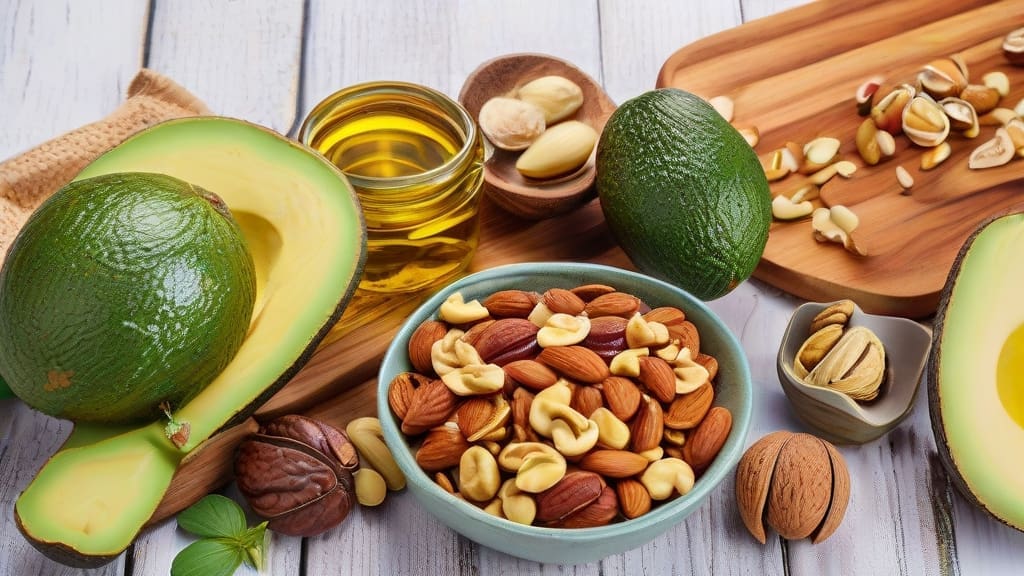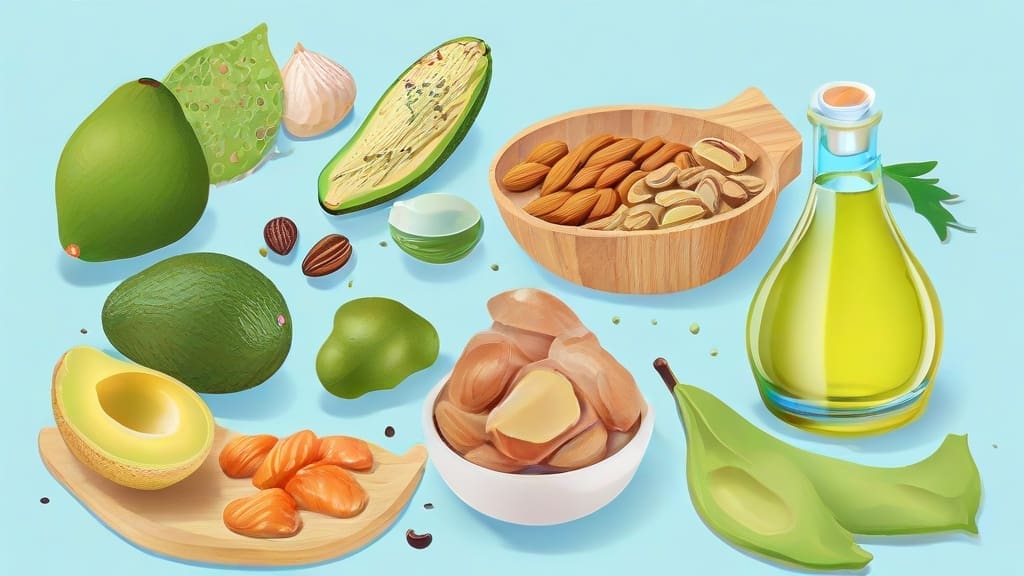Unveiling the Secrets of Healthy Fats
Let’s dig into the fascinating world of fats and their role in nourishing your body. Learn how the right fats can unlock a realm of benefits for your overall health.
The Basics of Fats in Nutrition
Fats are essential to a healthy diet and play several important roles in the body. Here are some basics of fats in nutrition:
Types of Fats:
- Saturated fats: Found in animal products like butter, cheese, and fatty meats, as well as some plant-based oils like coconut oil and palm oil. Consuming too much-saturated fat can raise cholesterol levels and increase the risk of heart disease.
- Trans fats: Often found in processed foods like fried foods, baked goods, and margarine. Trans fats are considered the most unhealthy type of fat and should be avoided as much as possible.
- Monounsaturated fats: Found in foods like olive oil, avocados, and nuts. These fats are considered heart-healthy and can help lower bad cholesterol levels.
- Polyunsaturated fats: This category includes omega-3 and omega-6 fatty acids, which are essential fats that the body needs but cannot produce on its own. Sources include fatty fish, flaxseeds, and walnuts.
Role in the body:
- Energy source: Fats are a concentrated source of energy, providing 9 calories per gram compared to 4 calories per gram from carbohydrates and protein.
- Insulation: Fats help insulate and protect your organs and help regulate body temperature.
- Nutrient absorption: Fats are essential for the absorption of fat-soluble vitamins (A, D, E, K).
- Cell function: Fats are a component of cell membranes and play a role in cell signaling and hormone production.
Recommended intake:
- The American Heart Association recommends that most fats be unsaturated, with saturated fats limited to less than 6% of daily calories.
- Limit trans fats as much as possible, as they have no known health benefits and have been linked to heart disease.
Healthy fat sources:
- Include sources of monounsaturated and polyunsaturated fats in your diet, such as olive oil, avocados, nuts, seeds, and fatty fish like salmon and sardines.
Remember, while fats are an important part of a healthy diet, it’s essential to consume them in moderation and choose healthier sources of fats to support overall health and well-being.

Benefits of Healthy Fats
Healthy fats play a crucial role in maintaining overall health and well-being. Here are some benefits of including healthy fats in your diet:
- Heart Health:
- Monounsaturated and polyunsaturated fats can help improve cholesterol levels by reducing LDL (bad) cholesterol and increasing HDL (good) cholesterol. This, in turn, can lower the risk of heart disease and stroke.
- Brain Function:
- Omega-3 fatty acids, in particular, are essential for brain health and cognitive function. They play a role in neurotransmitter function and brain development and may even help reduce the risk of cognitive decline.
- Nutrient Absorption:
- Fat-soluble vitamins (A, D, E, K) require fat to be absorbed by the body. Healthy fats help facilitate the absorption of these important vitamins, which are essential for various bodily functions.
- Cellular Health:
- Healthy fats are essential components of cell membranes, helping to maintain cell structure and integrity. They also play a role in cell signaling and gene expression.
- Inflammation Reduction:
- Omega-3 fatty acids in fatty fish, flaxseeds, and walnuts have anti-inflammatory properties. Including these healthy fats in your diet may help reduce inflammation linked to chronic diseases like heart disease, arthritis, and certain types of cancer.
- Satiety and Weight Management:
- Including healthy fats in your meals can help you feel fuller for longer, reducing the likelihood of overeating. They also add flavor and texture to foods, making meals more satisfying.
- Skin Health:
- Omega-3 and omega-6 fatty acids help maintain skin integrity, hydration, and flexibility. Including sources of these healthy fats in your diet may help improve skin health and appearance.
- Hormone Production:
- Fats are essential for the production of hormones in the body. Hormones play a vital role in various bodily functions, including metabolism, mood regulation, and reproductive health.
You can reap these benefits and support your overall health and well-being by incorporating sources of healthy fats, such as avocados, nuts, seeds, olive oil, and fatty fish. Remember, moderation is key, as fats are calorie-dense nutrients.
Distinguishing Between Good and Bad Fats
Distinguishing between good and bad fats is essential for healthy dietary choices. Here are some key points to help you differentiate between the two:
Good Fats (Healthy Fats):
- Monounsaturated fats:
- Sources: Olive oil, avocados, nuts (like almonds, cashews, and peanuts), and seeds (like sesame and pumpkin seeds).
- Benefits: It can help improve cholesterol levels, lower the risk of heart disease, and provide anti-inflammatory effects.
- Includes omega-3 and omega-6 fatty acids.
- Sources: Fatty fish (salmon, mackerel, sardines), flaxseeds, chia seeds, walnuts, soybean oil, and sunflower oil.
- Benefits: Omega-3s support heart health and brain function and reduce inflammation; omega-6s are essential for growth, skin health, and hormone synthesis.
Bad Fats (Unhealthy Fats):
- Saturated fats:
- Sources: Animal products (fatty cuts of meat, poultry with skin, full-fat dairy products) and some plant-based oils (coconut oil, palm oil).
- Effects: Consuming too much can raise LDL (bad) cholesterol levels, increasing the risk of heart disease and stroke.
- Trans fats:
- Sources: Partially hydrogenated oils found in processed foods like fried foods, baked goods, and packaged snacks.
- Effects: Raise LDL cholesterol, lower HDL (good) cholesterol, increase inflammation, and are associated with an increased risk of heart disease and other health problems.
Tips to Distinguish Between Fats:
- Read Labels:
- Check food labels for the type of fats listed. Avoid products containing trans fats and limit your intake of saturated fat.
- Watch for Solid Fats:
- Solid fats at room temperature, like butter and lard, tend to be high in saturated and potentially trans fats.
- Consider the Food Source:
- Choose whole-food sources of fats, such as nuts, seeds, avocados, fatty fish, and over-processed or fried foods.
- Cooking Methods:
- Opt for healthier cooking methods like baking, grilling, steaming, or sautéing with olive oil instead of deep-frying in unhealthy fats.
By being mindful of the types of fats you consume and making informed choices, you can prioritize healthy fats in your diet and reduce your intake of unhealthy fats to support overall health and well-being.

Tailoring Your Fat Intake
Tailoring your fat intake to meet your specific dietary needs and health goals is important for overall well-being. Here are some general guidelines on how to adjust your fat intake:
- Assess Your Health Goals:
- Consider your health goals, such as maintaining a healthy weight, improving heart health, or managing conditions like diabetes. Tailor your fat intake to support these objectives.
- Calculate Your Daily Caloric Needs:
- Determine your daily caloric needs based on factors like age, gender, weight, activity level, and goals. This will help you establish the appropriate amount of fat to include in your diet.
- Understand Recommended Fat Intake:
- The Dietary Guidelines for Americans recommend that fats should make up 20-35% of your total daily calorie intake. Aim to limit saturated fats and avoid trans fats, focusing on unsaturated fats instead.
- Balance Your Macronutrients:
- Ensure a balanced intake of macronutrients, including fats, carbohydrates, and proteins, to support overall nutritional needs. Adjust your fat intake based on your preferred macronutrient distribution.
- Choose Healthy Fat Sources:
- Include sources of healthy fats in your diet, such as avocados, nuts, seeds, olive oil, fatty fish, and plant-based oils. These fats provide essential nutrients and offer numerous health benefits.
- Monitor Portion Sizes:
- Be mindful of portion sizes when consuming high-fat foods, as fats are calorie-dense. Practice portion control to avoid overeating and manage calorie intake effectively.
- Consider Individual Factors:
- When tailoring your fat intake, consider individual factors such as food preferences, dietary restrictions, and sensitivities. Find suitable fat sources that align with your needs and preferences.
- Consult with a Healthcare Provider or Dietitian: (I won’t say it enough)
- Consult with a healthcare provider or registered dietitian for specific health concerns or dietary requirements. They can provide personalized guidance on adjusting your fat intake to meet your individual needs.
- Gradual Adjustments:
- Make gradual adjustments to your fat intake to allow your body to adapt to changes. Monitor how your body responds and make further modifications as needed.
By tailoring your fat intake based on your health goals, nutritional requirements, and individual factors, you can optimize your diet for overall health and well-being. Remember that balance, moderation, and variety are key principles in maintaining a healthy and sustainable dietary pattern.
Practical Tips & Meal Ideas
Incorporating more healthy fats into your meals can be delicious and beneficial for your overall health. Here are some ideas and tips to help you include healthy fats in your diet:
- Use Olive Oil for Cooking:
- Substitute butter or vegetable oil with olive oil when sautéing vegetables, cooking proteins, or making salad dressings. Olive oil is rich in monounsaturated fats and adds flavor to your dishes.
- Add Avocado to Your Meals:
- Mash avocado on toast, add it to salads, blend into smoothies, or use it as a creamy topping for soups. Avocado is a great source of healthy monounsaturated fats.
- Snack on Nuts and Seeds:
- Enjoy a handful of nuts (almonds, walnuts, pistachios) or seeds (flaxseeds, chia seeds) as a nutritious snack. Add them to yogurt, oatmeal, or salads for extra crunch and healthy fats.
- Include Fatty Fish in Your Diet:
- Fatty fish like salmon, mackerel, or sardines should be incorporated into your meals a few times a week. These fish are rich in omega-3 fatty acids, which benefit heart health and brain function.
- Top Your Meals with Nut Butter:
- Spread natural nut butter (such as almond or peanut butter) on whole grain toast or oatmeal, or add a dollop to smoothie bowls for a dose of healthy fats and protein.
- Use Seeds as a Topping:
- Sprinkle seeds like pumpkin, sunflower, or sesame seeds on salads, soups, or yogurt. Seeds are a great source of healthy fats, fiber, and nutrients.
- Cook with Coconut Milk:
- Use coconut milk in curries, soups, or smoothies for a creamy and flavorful addition. Coconut milk contains medium-chain triglycerides (MCTs), which are a type of beneficial fat.
- Make Homemade Salad Dressings:
- You can create your own salad dressings using olive oil, avocado oil, or flaxseed oil combined with vinegar, citrus juice, and herbs. This allows you to control the quality of the fats in your dressing.
- Sprinkle Flaxseeds or Chia Seeds:
- Boost your intake of omega-3 fatty acids by adding ground flaxseeds or chia seeds to yogurt, oatmeal, or baked goods. These seeds are versatile and easy to incorporate.
- Enjoy Dark Chocolate:
- Indulge in a square or two of dark chocolate with a high cocoa content (70% or higher). Dark chocolate contains healthy fats and antioxidants that can be a satisfying treat.
By incorporating these ideas and tips into your meals, you can easily increase your intake of healthy fats while enjoying a variety of delicious and nutritious foods. Remember to balance your fat intake with other essential nutrients for a well-rounded diet.
Conclusion:
Embracing the power of healthy fats is a key component of a well-rounded and nutritious diet. By incorporating sources of healthy fats into your meals, you can enjoy a wide range of benefits for your overall health and well-being. Healthy fats play essential roles in the body, from supporting heart health and brain function to aiding in nutrient absorption and reducing inflammation.
Making simple yet intentional changes to include healthy fats in your diet can significantly impact your health. Whether you choose to cook with olive oil, snack on nuts and seeds, include fatty fish in your meals, or opt for nutrient-dense avocados, embracing healthy fats can be both delicious and rewarding.
Remember to focus on whole food sources of healthy fats, avoid or limit unhealthy fats like trans fats, and maintain a balanced approach to your overall fat intake. By doing so, you can create flavorful and satisfying meals while prioritizing your health and longevity.
By understanding the benefits of healthy fats, exploring various ways to incorporate them into your diet, and making mindful choices in your daily food consumption, you can harness the power of healthy fats to support a healthier lifestyle and enhance your well-being.









Be First to Comment